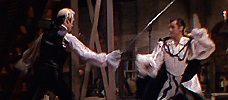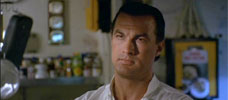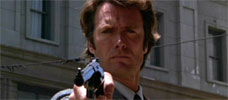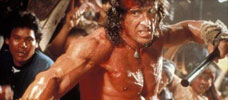Reviews
Paul Michael Glaser
USA, 1987
Credits
Review by Adam Balz
Posted on 25 June 2009
Source Republic Pictures DVD
Categories Favorites: The Action Movie
In the cluttered field where politics, film, and pop culture meet, you will find The Running Man at the center of the intersection, unchallenged. A 1987 film about a futuristic dystopia where justice is nothing more than a corrupt game show, The Running Man is based on a novel written by Stephen King under the pseudonym Richard Bachmann—a novel, King admitted in his 2002 memoirs, he wrote uncharacteristically in the span of a single week. The film’s director, Paul Michael Glaser, is known primarily for his portrayal of the former in Starsky and Hutch, and the film’s screenwriter, Steven E. de Souza, is responsible for the first two Die Hard films, among other pictures. The film’s stars include Arnold Schwarzenegger, the bodybuilder-turned-actor-turned-governor, whose physique and attitude lie in direct contrast to the character King devised years earlier; Richard Dawson, a game show fixture from the 1970s who here also portrays a game show host; football player Jim Brown; a handful of professional wrestlers, including Jesse Ventura, who would later become a governor himself; a founding member of Fleetwood Mac; and Dweezil Zappa, son of a rock ‘n’ roll legend. In fact, only Maria Conchita Alonso and Yaphet Kotto, who play Schwarzenegger’s love interest and one of his fellow contestants respectively, come to this film with any hint of what one might consider a normal career.
Set in the year 2019, in a United States where an economic collapse and a scarcity of food has transformed the government - now divided into a parliament-style set of regions - into a harsh and violent police state, the film first finds Schwarzenegger’s Ben Richards piloting a military helicopter over Bakersfield, where a “food riot” has consumed the city. Ordered to fire on the crowd of unarmed civilians, Richards refuses, and after a short struggle he is overpowered by his crew, who proceed to mow down the crowd—an act the government will quickly blamed on Richards, who is then dubbed “the Butcher of Bakersfield.”
Eighteen months later, we find him in a work camp where, along with other inmates, he stages an escape by overpowering the guards and disarming an electrified fence. Finding brief respite in an apartment once owned by his brother, but now occupied by a young woman named Amber, he seeks safe passage out of California and takes Amber as a sort of unharmed hostage, using her credentials to pass himself off as her husband while making a clean escape. Amber, as it happens, works for ICS, a company that produces “The Running Man,” a television show in which convicts are forced into fighting for their lives on national television against charismatic and much-beloved killers, known in the game-show universe as “Stalkers.” When, at an airport, Amber manages to free herself from Richards’ clutches and call attention to who he is, we already know that Richards’ destination is assured: He will be a Runner.
We know this because, in a previous scene, the host of “The Running Man” catches a glimpse of Richards on a news broadcast and personally requests him. The host is Damon Killian, and his ratings have, much to his annoyance, plateaued. This shouldn’t be a concern, considering Killian not only has the highest rated and most watched show in the county, but also has the ear of the government—that is, if he’s not already the government himself. He has direct access to the president of the United States, including a new and chilling addition to the Department of Justice—the Entertainment Division. This is a future without judges or juries, without Miranda Rights or due process, without warrants or evidence—a future where certain choice amendments of the Constitution have been erased, substituted with a man with a nice suit and microphone.
Richards is, of course, taken out of military custody and made a Runner, an act that, as Killian’s assistant notes, is unprecedented. It’s also wholly indicative of the reach of the television host’s influence and power throughout the country. Richards is brought on stage, introduced to the live audience against a thunder of jeering - he is, after all, the Butcher of Bakersfield, a lie that is reinforced through doctored video of him firing on the unarmed crowd - and set down in a metal cart that will deliver him, at an unimaginable velocity, through underground tunnels, into the massive, 400-square-foot arena. He will be joined, as Killian notes, by two of his fellow camp inmates, Weiss and Laughlin, who are members of an underground group working to jam ICS’s satellites and free the nation from the government totalitarian rule.
What follows is, of course, the game. The arena appears to be nothing more than a massive, back-alley junkyard ornamented with the occasional camera. (In fact, one struggles to see where Glaser could have filmed these sections of the movie, as the sets appear to be too large for a studio but too enclosed and disorderly to be an actual location.) Soon, Killian, with assistance from the loyal studio audience, unleashes a succession of Stalkers, from Subzero - a wide-shouldered ice-skater equipped with a serrated hockey-stick - to Buzzsaw, whose name denotes his choice in weaponry, and Dynamo, a rotund and operatic man whose electronic get-up resembles a sloppy and incomplete piece of Lite-Bright artwork. Each is eventually dispensed with, and in increasingly grisly ways, all to the horror of the audience and seeming indifference of Damon Killian. In a phone call with the U.S. Attorney General during a commercial break, he dismisses the first death as inevitable, all while having his make-up retouched. In his mind, this is all for the betterment of his ratings.
As is customary with action films, and especially with those starring Arnold Schwarzenegger, there are obvious goofs and plot holes, the least of which is the underground’s strange ability to somehow base their operation in the center of the arena without being noticed by, say, a camera or member of the ICS staff. Similarly, it’s strange that a conglomerate as monstrous as ICS would refrain from exploiting the story of Amber’s horrible ordeal, one of its own staff, instead dumping her in the game arena—a risky move, considering not only her widespread notoriety but also her familiarity with the company’s workings. It’s hard to imagine a television network today deciding not to misuse the trials and tribulations of its own people—hard, mainly because we’ve already seen it happen countless times, and often at great length.
In fact, for all its belabored, Reagan-era abstractions, there is one aspect of The Running Man that has become oddly yet increasingly relevant, and what, in my mind, makes Glaser’s film especially noteworthy: its commentary on the inherent dominance of television.
In the closing scene, as Richards finally confronts Killian, the host attempts to justify his actions by shifting responsibility:
This is television, that’s all it is. It has nothing to do with people; it’s to do with ratings! For fifty years, we’ve told them what to eat, what to drink, what to wear. For Christ’s sake, Ben, don’t you understand? Americans love television. They wean their kids on it. Listen, they love game shows, they love wrestling, they love sports and violence. So what do we do? We give ‘em what they want! We’re number one, Ben, that’s all that counts, believe me. I’ve been in the business for thirty years.
Richards smirks and delivers the obligatory one-line retort, then drops Killian into a metal cart and sends him rushing down the game tunnel towards an explosive end. And yet, strangely, Killian’s speech highlights an important point: that the men and women who make up his massive audience are complicit in what happens on “The Running Man” program, perhaps even more so than Killian himself.
In this respect, The Running Man has an unlikely and entirely more revered bedfellow: Charlie Chaplin’s The Great Dictator. A satire of Adolf Hitler and the danger of Nazism, Chaplin’s film centers on two men: a squat and polarizing dictator named Hynkel, and an unnamed Jewish barber who suffers under that dictator’s anti-Semitic sentiments, both of whom are played by Chaplin himself. As Hynkel delivers fiery speeches to teeming crowds, the barber - an amnesic ex-soldier - woos a young woman living on his block, a telling contrast between the concerns of both men. Throughout the film, the barber must deal with increasingly anti-Semitic attacks, including internment in a concentration camp, until near the film’s end, Chaplin’s nameless hero finds himself in Hynkel’s place and, standing before yet another teeming crowd, appeals for peace. The cheers he receives are thunderous. And yet, as academic Slavoj Zizek has pointed out, they are remarkably - and intentionally - similar to the cheers Hynkel himself received when spewing anti-Semitic rhetoric. This, Zizek postulates, is the overriding message of Chaplin’s film, a commentary on how we as people become vacant-brained followers rather than critical and questioning thinkers.
Such is the case with The Running Man. As Killian’s body burns, the camera cuts to a crowd of people gathered in the plaza outside the ICS skyscraper. They teem in the roundabout where they would usually greet Killian’s limo every morning—only now they cheer for Richards with the same deep and loyal fervor. A tyrant has been replaced by a hero, and yet nothing beyond the studio - nothing, at least, in the national population - seems to have changed. The same hero worship that made Damon Killian a beloved figure, that undoubtedly made “The Running Man” such a popular game, has now attached itself to Ben Richards, and the future as we understand it now belongs in his hands.
This attention also explains the popularity of Arnold Schwarzenegger himself—why an Austrian bodybuilder became such an assured box-office draw and, ultimately, the governor of the nation’s most populous state. An intimidating yet likable man, Schwarzenegger has a charisma that translates nicely to film, to the point that even his rare villainous roles - as the T-800 in The Terminator and, thirteen years later, as Mr. Freeze in Batman and Robin - still appeal somewhat, if only because of a heartbreaking backstory, as is the case with the latter role. It’s a charisma that led him to the Governor’s Mansion following a campaign in which, true to his fictional counterparts, he delivered hackneyed one-liners to teeming audiences just before trouncing a succession of charismatic challengers.
More Favorites: The Action Movie
-

First Blood
1982 -

The General
1926 -

The Running Man
1987 -

Guns
1990 -

Highlander
1986 -

Death Race 2000
1975 -

Scaramouche
1952 -

Do or Die
1991 -

Thief
1981 -

Mission: Impossible
1996 -

Invasion U.S.A.
1985 -

Rambo: First Blood Part II
1985 -

Bullitt
1968 -

Hard Hunted
1992 -

The Fugitive
1993 -

Kindergarten Cop
1990 -

Under Siege
1992 -

Dirty Harry
1971 -

Rambo III
1988 -

Public Enemies
2009 -

Day of the Warrior
1996 -

The Good, the Bad, the Weird
2008 -

Straw Dogs
1971 -

Die Hard
1988 -

Con Air
1997 -

Collateral Damage
2002 -

Rambo
2008
We don’t do comments anymore, but you may contact us here or find us on Twitter or Facebook.



